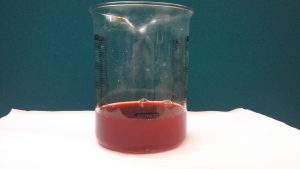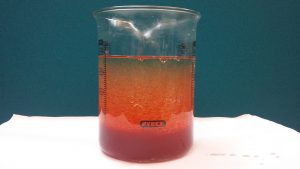This week’s experiment will show you how to create the 1960’s invention – the lava lamp – at home!
You can create your lava lamp in a beaker, a glass or a plastic bottle, whatever you have lying around that you can see through.
- Start by filling your container 1/4 full with water and add some food colouring of your choice.

- Add oil until its nearly full to the top. Wait a minute or two and the oil should separate out and sit above the water.

- Drop in a Alka-Seltzer or any other effervescent (fizzy) tablet and watch the bubbles rise.

The Science
Oil floats on top of water because it is less dense and water molecules stick closely together due to their hydrogen bonds, making it difficult for the oil to mix in.
The tablet is more dense than the oil and the water so sinks directly to the bottom. There it reacts with the water to produce the gas, carbon dioxide (CO2). CO2 is less dense than both the water and oil so it rises to the top, carrying some water molecules with it, these are the bubbles that you can see. The bits dropping back down are the water molecules sinking again once the gas has escaped.
A real lava lamp uses wax that is heated by a bulb. The hot wax expands, becomes less dense than the water and so rises. When it cools, it shrinks, becomes denser and sinks.